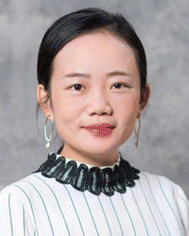Themed collection on molecular scale electronics
Timothy A.
Su
 *ab,
Michael S.
Inkpen
*ab,
Michael S.
Inkpen
 *c and
Haixing
Li
*c and
Haixing
Li
 *d
*d
aDepartment of Chemistry, University of California, Riverside, CA 92521, USA
bMaterials Science and Engineering Program, University of California, Riverside, CA 92521, USA. E-mail: timothys@ucr.edu
cDepartment of Chemistry, University of Southern California, Los Angeles, CA 90089, USA. E-mail: inkpen@usc.edu
dDepartment of Physics, City University of Hong Kong, Kowloon 999077, Hong Kong SAR, China. E-mail: haixinli@cityu.edu.hk
This themed collection in the Journal of Materials Chemistry C provides a window into the most exciting trends and questions that currently grip the field of molecular scale electronics. Interest in molecular electronics—to use individual molecules as the active elements in electronic circuitry—dates back to the 1950s, where Air Force and corporate interests aligned in a vision to make miniaturized electronics through bottom-up rather than top-down approaches, as the molecular scale represents the ultimate limit of device miniaturization.1 In 1974, Aviram and Ratner provided the first vision for what such a functional molecular electronic component might look like in a molecular rectifier.2 Scanning tunneling microscopy-based techniques and related approaches ultimately provided the means to rapidly characterize the electronic properties of an extensive range of molecular junctions.3–9
While it is still a central aspiration to make practical electronics from molecules, this is no longer the singular driving motivation for the field. New research directions have branched off from this initial goal, leading to perhaps the most interesting lines of inquiry. We can use the tools developed to probe molecular junctions for discovering novel quantum transport phenomena that emerge only at the molecular scale, achieve molecular level insight into the properties of bulk materials, and explore how concepts from physical organic chemistry or interfacial chemical reactions can be used to control quantum transport through molecules. Molecular electronics is now about so much more than whether we can make a practical molecular electronic—it has become a platform for discovering new fundamental science through the unique lens of tunneling transport.
Over the last three decades, measurement and modeling approaches have grown in both sophistication and accessibility, attracting a growing base of scientists working together across synthesis, theory, measurement, and device engineering to explore these fundamental questions, with some collaborations happening across the globe. Indeed, a diverse cohort of international researchers are featured in this themed collection.
One flavor of molecular electronics seeks to interrogate molecules forming dense self-assembled monolayers that are probed in large-area junctions. In this themed collection, Cea, Martin, and coworkers are exploring the use of transparent and flexible electrodes (https://doi.org/10.1039/D3TC02237D) within this context toward wearable molecular electronic devices. Meanwhile, Li and coworkers take a different approach and consider using conductive ionogels to replace conventional electrodes in large-area junctions that operate under aqueous environments necessary for bioelectronic applications (https://doi.org/10.1039/D3TC03733A). Finally, Lambert, J. Wang, X. Wang, Ismael, and coworkers apply stepwise assembly approaches to develop molecular arrays on graphene electrodes for thermoelectric applications (https://doi.org/10.1039/D3TC02842A).
It has also been appreciated how the nature of the electrode–molecule contact influences molecular conductance and mechanical stability properties. We have only explored a limited chemical space when it comes to linker group design. In this collection, Zhou, Wang, Chen, and coworkers explore how the coordination modes and denticity of triazole contact groups on gold electrodes influence single-molecule junction conductance (https://doi.org/10.1039/D3TC03618A). Lacroix, Sun, and coworkers investigate linker engineering through a mixed diazonium–amino linker system to create highly robust porphyrin-based single-molecule junctions, with junction lifetimes up to 70 seconds (https://doi.org/10.1039/D3TC04142E). Hou and coworkers apply theories to study the use of oxazine-based linkers that may serve as covalent anchors for carbon nanoelectrodes (https://doi.org/10.1039/D3TC03720G).
The nature of the electrode–linker contact is complex, as there are multiple ways a linker can interact with electrodes, with each leading to its own conductance signature. However, it is difficult to tease these out from a single histogram that compiles all measurement traces. Van Veen, Ornago, van der Zant, and El Abbassi describe a generalized neural network approach to separate traces that contain molecular plateaus from traces where no molecule connects in the junction to facilitate interpretation of molecular conductance measurements where the junction formation probability is low (https://doi.org/10.1039/D3TC02346J).
There has been mounting interest in exploring new concepts for how molecular connectivity in the molecular backbone can be used to control quantum transport. Moth-Poulsen and coworkers explore a bond connectivity switch in the norbornadiene/quadricyclane scaffold showing that thioacetate- and tert-butyl-terminated molecules outperform the methyl thioether-terminated ones (https://doi.org/10.1039/D3TC02652C). Venkatramani and coworkers computationally explore the impact of pyridyl nitrogen’s ortho-, meta-, and para-connectivity on electronic transmission in polypyridyl molecular wires (https://doi.org/10.1039/D3TC02651E). Mota and coworkers computationally study how ring size and connectivity in graphene nanoribbons impact transport properties in nanodevices (https://doi.org/10.1039/D3TC03701K). Guo, Jia, Li, and coworkers summarize related concepts in designing non-volatile memories in single molecule devices in their review article (https://doi.org/10.1039/D3TC03724J).
Another emerging area is to explore how anti-aromatic backbones impact molecular junction properties, as these are expected to demonstrate heightened molecular conductance.10,11 Here, Zotti, Leary, and coworkers computationally investigate charge transport in non-alternant antiaromatic dithienopentalenes (https://doi.org/10.1039/D3TC04266A). Nishino and coworkers provide new insight into the nature of π-stacking van der Waals interactions in antiaromatic molecules via atomic force spectroscopy in large-area junctions (https://doi.org/10.1039/D3TC04166B). Another area of emerging interest lies in understanding the impact of spin on molecular electronics and spintronics, particularly in organometallic complexes. Hou and coworkers model spin-polarized currents in square-planar iron complexes (https://doi.org/10.1039/D3TC03719C). Meanwhile, Schneider, Feyer, Cojocariu, Carlotto, and coworkers explore the impact of π-conjugation on magnetic anisotropy in nickel tetraphenylporphyrin complexes for spintronic applications (https://doi.org/10.1039/D3TC02726K).
In concert, these articles highlight the diversity of research questions and approaches at the forefront of molecular scale electronics.
References
- H. Choi and C. C. M. Mody, The Long History of Molecular Electronics: Microelectronics Origins of Nanotechnology, Soc. Stud. Sci., 2009, 39(1), 11–50, DOI:10.1177/0306312708097288.
- A. Aviram and M. A. Ratner, Molecular Rectifiers, Chem. Phys. Lett., 1974, 29(2), 277–283, DOI:10.1016/0009-2614(74)85031-1.
- M. A. Reed, C. Zhou, C. J. Muller, T. P. Burgin and J. M. Tour, Conductance of a Molecular Junction, Science, 1997, 278(5336), 252–254, DOI:10.1126/science.278.5336.252.
- D. J. Wold and C. D. Frisbie, Formation of Metal–Molecule–Metal Tunnel Junctions: Microcontacts to Alkanethiol Monolayers with a Conducting AFM Tip, J. Am. Chem. Soc., 2000, 122(12), 2970–2971, DOI:10.1021/ja994468h.
- X. D. Cui, A. Primak, X. Zarate, J. Tomfohr, O. F. Sankey, A. L. Moore, T. A. Moore, D. Gust, G. Harris and S. M. Lindsay, Reproducible Measurement of Single-Molecule Conductivity, Science, 2001, 294(5542), 571–574, DOI:10.1126/science.1064354.
- R. H. M. Smit, Y. Noat, C. Untiedt, N. D. Lang, M. C. van Hemert and J. M. van Ruitenbeek, Measurement of the Conductance of a Hydrogen Molecule, Nature, 2002, 419(6910), 906–909, DOI:10.1038/nature01103.
- B. Xu and N. J. Tao, Measurement of Single-Molecule Resistance by Repeated Formation of Molecular Junctions, Science, 2003, 301(5637), 1221–1223, DOI:10.1126/science.1087481.
- L. Venkataraman, J. E. Klare, C. Nuckolls, M. S. Hybertsen and M. L. Steigerwald, Dependence of Single-Molecule Junction Conductance on Molecular Conformation, Nature, 2006, 442(7105), 904–907, DOI:10.1038/nature05037.
- R. C. Chiechi, E. A. Weiss, M. D. Dickey and G. M. Whitesides, Eutectic Gallium–Indium (EGaIn): A Moldable Liquid Metal for Electrical Characterization of Self-Assembled Monolayers, Angew. Chem., Int. Ed., 2008, 47(1), 142–144, DOI:10.1002/anie.200703642.
- R. Breslow and F. W. Foss Jr, Charge Transport in Nanoscale Aromatic and Antiaromatic Systems, J. Phys.: Condens. Matter, 2008, 20(37), 374104, DOI:10.1088/0953-8984/20/37/374104.
- W. Chen, H. Li, J. R. Widawsky, C. Appayee, L. Venkataraman and R. Breslow, Aromaticity Decreases Single-Molecule Junction Conductance, J. Am. Chem. Soc., 2014, 136(3), 918–920, DOI:10.1021/ja411143s.
| This journal is © The Royal Society of Chemistry 2024 |



